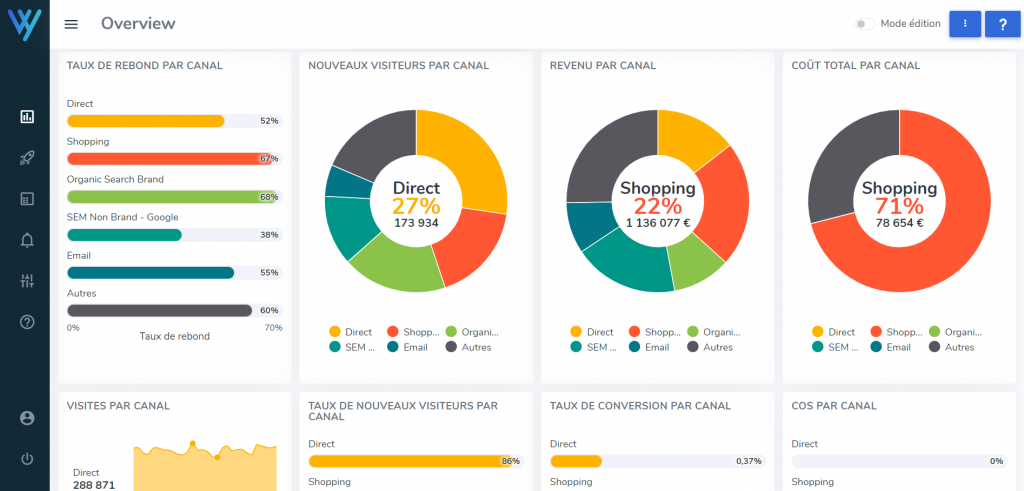Imagine you’re a maestro conducting an orchestra, where every musician represents a different customer touchpoint. Your role is to ensure that each section plays in harmony to deliver a symphony that resonates with your audience—your customers. But how do you achieve such cohesion in a landscape that’s constantly evolving with new channels and consumer behaviors? Have you ever pondered whether your marketing strategies are truly in sync with your customers’ journeys? Are you harnessing the full potential of machine learning to interpret complex customer data?
The advent of AI and machine learning has revolutionized the way we track, analyze, and respond to customer journeys. As a marketing leader, your mission is to master these tools to craft experiences that not only meet but exceed customer expectations. This article delves into the intricacies of machine learning-driven customer journey analytics, unveiling strategies to not just map, but to shape customer pathways. For the visionary marketer, it’s not just about following the journey—it’s about leading it.
Building a Customer Journey Map with Precision Analytics
In the realm of customer journey mapping, precision is paramount. The first strokes on the canvas of journey mapping involve collecting vast amounts of data from various touchpoints. How do you ensure that every touchpoint is accurately represented and analyzed? The answer lies in machine learning algorithms that can sift through data, discern patterns, and predict future behaviors with remarkable accuracy.
Machine learning transforms raw data into a dynamic customer journey map, offering a granular view of each step a customer takes. For instance, when integrated with Google Analytics, machine learning can provide insights into the efficacy of each channel, helping you to optimize your marketing spend. But it’s not just about where customers interact with your brand; it’s about understanding the sentiments behind those interactions. Natural language processing, a subset of machine learning, allows us to interpret customer feedback, reviews, and inquiries, adding depth to the journey map.
Furthermore, by tracking user journeys, marketers can identify critical points where customers drop off or engage more deeply. This tracking extends beyond mere observation; it enables proactive engagement. Imagine preempting customer needs and addressing them before they even arise—this is the power of machine learning in journey mapping.

The Impact of Machine Learning on Customer Experience Strategies
The customer experience is no longer a linear narrative; it’s an intricate web of interactions that machine learning can decode. By analyzing customer behavior, preferences, and engagement levels, AI-powered analytics software provides actionable insights to tailor the customer experience like never before. But the real question for marketing experts is: How can these insights be transformed into strategy?
Machine learning offers predictive capabilities that inform not just reactive strategies, but also proactive measures. For example, by analyzing the best customer journeys, machine learning can forecast potential churn and suggest interventions. This level of analytics enables a shift from standard customer service to personalized customer experiences.
Moreover, machine learning aids in the segmentation of customers, allowing for more targeted marketing campaigns. It recognizes patterns that humans might overlook, such as subtle shifts in customer behavior that signal a change in needs or preferences. By leveraging this intelligence, marketing professionals can design experiences that resonate on an individual level, fostering loyalty and enhancing customer lifetime value.

Customer Journey Tracking: A Step Towards Personalization
As we dive deeper into customer journey tracking, the focus sharpens on personalization—the cornerstone of modern marketing. Machine learning does not merely track the steps of a customer’s journey; it uncovers the motivations behind those steps. This insight is critical for marketing directors seeking to curate highly personalized experiences.
Through AI, journey tracking evolves from a passive record to an active tool for engagement. Each interaction becomes an opportunity to learn and adapt. For instance, machine learning algorithms can analyze how customers respond to various content types, offers, and communication channels, enabling marketers to fine-tune their approaches in real-time.
But how can we use customer journey analytics to improve customer retention? Consider the use of AI to identify patterns that precede customer drop-off points. Armed with this knowledge, marketing teams can intervene with personalized incentives, content, or assistance, turning potential loss into a strengthened relationship.

How AI is Shaping the Customer Journey in Real-Time
Artificial intelligence isn’t just reshaping the customer journey; it’s doing so as events unfold. Real-time journey tracking means that AI systems are constantly receiving and analyzing data, allowing for immediate adjustments to marketing tactics. This capability is especially critical in a digital ecosystem where timing can be the difference between a sale and a missed opportunity.
By utilizing machine learning algorithms, marketers can monitor customer behavior across various channels instantly. If a potential customer abandons a shopping cart, an AI system can trigger a tailored email or an incentive to re-engage them, effectively nipping conversion issues in the bud. This level of agility in customer journey tracking ensures that the customer experience is seamless, regardless of the touchpoints involved.
The real-time analysis also extends to social media interactions and customer service inquiries. AI can evaluate sentiment, flagging negative experiences and prioritizing them for immediate attention. This rapid response capability demonstrates to customers that their satisfaction is paramount, thereby enhancing the overall customer experience and reinforcing brand loyalty.

Optimizing for the Best Customer Journey with Advanced Analytics
The quest for the best customer journey is an ongoing one, and advanced analytics serve as the compass. By delving into the intricacies of journey data, machine learning provides insights that are not just descriptive but predictive and prescriptive as well. It’s about understanding what will happen next and what actions should be taken to influence the outcome positively.
Advanced analytics can pinpoint the most effective pathways that lead to conversion and loyalty. By analyzing patterns over time, AI helps in crafting not just a single journey but a comprehensive journey landscape that accommodates the diversity of customer behaviors and preferences. This level of optimization requires an understanding of customer lifetime value and how it can be influenced by every interaction with the brand.
For the director-level marketer, these analytics offer a dashboard of possibilities. By understanding customer propensities, you can allocate resources more effectively, personalize marketing efforts, and ultimately, secure a better return on investment. This strategic application of customer journey analytics transcends traditional marketing—it’s a step into a future where every decision is data-driven.

Natural Language Processing: Understanding Customer Sentiments
Natural language processing (NLP) stands as one of the most transformative elements of machine learning in the context of customer journey analytics. NLP allows machines to understand human language, gleaning insights from customer feedback, queries, and social media conversations. This understanding goes beyond mere words; it encompasses the sentiments and emotions conveyed.
For a marketing professional, the implications of NLP are profound. It enables a deeper comprehension of the voice of the customer, ensuring that strategies are not just data-informed but emotion-aware. By analyzing customer sentiments, businesses can detect emerging trends, gauge brand perception, and refine messaging to resonate more deeply with their audience.
Furthermore, NLP can automate and enhance customer service interactions, providing responses that are not only timely but also contextually relevant. This technology empowers brands to handle customer inquiries with a level of sophistication that mirrors human understanding, yet with the efficiency and scalability that only AI can provide.

Increasing Customer Lifetime Value with Predictive Journey Mapping
The digital footprint of a customer’s interaction with a brand is rich with clues about future behavior. By employing predictive analytics, we gain the foresight to influence not just the present but also the future of the customer-brand relationship. This approach to mapping out customer interactions relies on sophisticated algorithms that identify patterns and anticipate outcomes, allowing brands to take proactive steps in nurturing customer relationships.
This strategic foresight is particularly useful in enhancing the customer lifetime value. It allows brands to craft personalized experiences that resonate with individual customers, increasing engagement and loyalty. By understanding the potential future actions of customers, marketing strategists can design campaigns that are more likely to result in long-term retention and higher lifetime value.
The nuanced understanding of a customer’s interactions also empowers brands to allocate their resources more effectively, ensuring that efforts are concentrated where they will have the most significant impact. This not only optimizes marketing budgets but also ensures that customers feel valued and understood, further solidifying their connection to the brand.

Utilizing Wizaly for Comprehensive Interaction Tracking
Within the diverse landscape of analytics platforms, Wizaly distinguishes itself with sophisticated capabilities in capturing and analyzing various customer interaction points. This platform’s strength is its ability to synthesize and interpret data across the spectrum of the digital environment where the paths of customers and brands intersect.
Employing such an all-encompassing analytics solution provides a comprehensive view of consumer behavior. Marketers can assess the impact of different channels on customer engagement and conversion, shaping their strategies for peak efficiency. The goal is to base every marketing move on a deep and nuanced comprehension of the customer’s journey through the digital realm.
In addition, the detailed insights obtained through Wizaly enable the fine-tuning of touchpoints to maximize their potential. Marketers are equipped to hone their approaches, turning each customer interaction into a moment that positively shapes perceptions and influences actions in favor of the brand.

In wrapping up, remember that the essence of modern marketing is to create resonant experiences that captivate and satisfy customers at every point of interaction. The strategic application of advanced analytics empowers brands to elevate their marketing efforts to new heights, ensuring that every campaign is insightful, impactful, and infused with a deep understanding of customer behavior.
For those at the helm of marketing strategy, the message is clear: embracing comprehensive analytics and predictive insights is not just innovative; it’s imperative. It’s what distinguishes proactive leaders in the market who are not just riding the wave of digital transformation but are steering it toward unprecedented success.
As you contemplate the future of your marketing initiatives, consider how a partnership with Wizaly could elevate your ability to connect with customers in meaningful ways. Reach out to explore how their platform can refine your marketing strategies, enhance customer engagement, and drive significant growth for your brand. Let the journey toward exceptional marketing attribution and customer insights begin with Wizaly.



